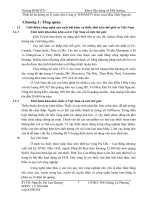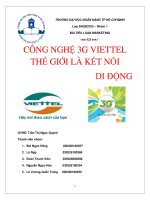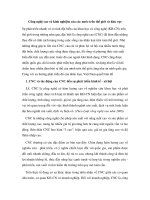công nghệ hydrat trên thế giới
Bạn đang xem bản rút gọn của tài liệu. Xem và tải ngay bản đầy đủ của tài liệu tại đây (345.85 KB, 5 trang )
Journal of Chemical Engineering, IEB
Vol. ChE 27,No. 2, December, 2012
Study of Hydrate Formation and Inhibition for LPG
Mridul Sarker, Debasish Chowdhury, Iqbal Hossain*
Department of Chemical Engineering, Bangladesh University of Engineering & Technology,
BUET, Dhaka-1000.
Abstract
Liquefied petroleum gas (LPG) has already been proved as an efficient fuel and feedstock for many chemical and
petrochemical industries. Hydrate formation can create serious problems in the production, transmission, storage, and
end-use of LPG. Hence an adequate knowledge on hydrate formation (i.e., the effects of moisture content and pressure
on the hydrate formation temperature) is crucial to maintain the process conditions out of the hydrate formation region.
However the study particularly on such aspects is scarcely available in literature. Therefore the effects of moisture
content and pressure on the LPG hydrate formation temperature are studied extensively. A correlation is also developed
to predict hydrate formation temperature for various LPG compositions. Hydrate inhibition performances of various
inhibitors are also evaluated. Aspen-HYSYS process simulator is used to perform the study. The present study provides
useful information to reduce the hydrate formation of LPG.
1. INTRODUCTION
2. METHODOLOGY
Liquefied petroleum gas, also called LPG, is
a flammable mixture of hydrocarbon gases, mostly
propane and butane, along with trace amounts of higher
hydrocarbons. It is a clean-burning and environmental
friendly efficient fuel with minimum sulphur content,
which can be a vital source of energy for next
generation low carbon world due to an immediate and
global availability, its natural by-product origin,
transportation flexibility and diverse applications.
Millions of people presently use LPG and depend on it
for thousands of applications, in commercial business,
in industry, transportation, farming, power generation,
cooking, and heating purposes. LPG hydrates are solids
crystalline compounds, resembling ice or wet snow in
appearance, that form from a combination of moisture
and one or more hydrocarbon gases. Formation of gas
hydrates depends on several criterion and they are
stable only under specific pressure-temperature
conditions. Gas hydrates can cause several problems in
the production, transportation, storage and use of
liquefied petroleum gases. Hydrate formation can be
prevented by injecting additives as hydrate inhibitor.
Injection of inhibitor also depends on compositions of
LPG and degree of inhibition required. Appropriate
and specific data on LPG hydrate formation conditions
and prevention of LPG hydrate formation by inhibitors
are important to know which are hardly available in
literature. Particularly the non-ideality of LPG mixture
due to the presence of moisture in commercial LPG
must be accounted in the prediction of hydrate
formation conditions. Therefore, the hydrate formation
conditions and inhibition of hydrates of LPG is studied
in the present research considering the non-ideality
(i.e., presence of moisture). To carry out this study the
Aspen Hysys V7.3 process simulator is employed.
Pure experimental setup with high accuracy and
consistency for evaluating hydrate formation
temperature is rarely available. Hence, simulation
approach is adopted for estimating hydrate formation
temperature. Aspen HYSYS process simulator is a core
element of AspenTech’s aspenONE® Engineering
applications [1]. It has already been proved as an
efficient simulator with reasonable accuracy. It offers a
comprehensive thermodynamics foundation for accurate
determination of physical properties, transport
properties, and phase behavior. Aspen HYSYS can be
used to determine outlet process conditions if the inlet
conditions like temperature, pressure, and composition
are specified. Therefore, a LPG mixture or stream is
simulated combining propane, n-butane, and other
components of desired compositions at the specified
condition in user interface of Aspen-HYSYS as shown
in fig. 1. Hydrate formation utility tool of Aspen-Hysys
can generally be used to determine hydrate formation
temperature. The hydrate formation utility calculates the
incipient solid formation point for hydrates in a given
stream. The predictive models are based on fundamental
thermodynamic principles and use equation-of-state
generated properties in calculating the equilibrium
conditions. These predictive models can therefore be
applied to various compositions and extreme operating
conditions with a greater degree of reliability than one
may expect with empirical expressions or charts. Hence,
this utility tool is used to carry out this study, for the
simulated LPG stream as shown in Fig. 2. CSM model,
a new hydrate model developed by the Colorado School
of Mines (CSM) is used to find out hydrate formation
temperature in this study. This model also follows the
formulation of Van Der Waals and Platteeuw but with
very significant enhancements to thermodynamic
models for the hydrate and aqueous phases [1]. CSM
model can be used for all possible scenarios; vapor-
*
Corresponding Author: Iqbal Hossain,
E-mail:
60
hydrate, liquid-hydrate, aqueous-hydrate, vapor-liquidhydrate, vapor-aqueous-hydrate, and vapor-liquidaqueous-hydrate (where liquid refers to a hydrocarbon
liquid). This model is used for hydrate predictions of
the types I and II and for cases with and without
inhibitors. The CSM model can be used with the SRK,
Peng-Robinson and Glycol property packages. In this
current study Peng-Robinson is chosen as fluid package
to complete the simulation of LPG stream.
different inhibitors (e.g., methanol, ethylene glycol,
diethylene glycol, and triethylene glycol). A curve is
also produced to find out inhibitor amount needed to
inhibit hydrate up to a desired degree of inhibition.
Fig. 1: Simulation of LPG mixture for evaluating
hydrate formation temperature by Aspen-Hysys
3.1 Effect of Moisture Content on Hydrate
Formation Temperature
Commercial LPG always contains different impurities
like moisture, methyle-mercaptan, higher and lower
hydrocarbons. Nevertheless, in this study only moisture
content is considered as impurity to avoid complexity
and to investigate the effect of free water content on
hydrate formation temperature.
An addition of very small amount of moisture in
propane-butane mixture results in a sudden reduction of
hydrate formation temperature from initial point.
Several curves are plotted for a reasonable moisture
content range (2.5%, 5%, and 7.5%) at certain pressure
to determine the effect of further addition of moisture
content on hydrate formation temperature.
3. RESULTS AND DISCUSSION
LPG hydrates are included in a general class of
compound known as clathrates, which have a structure
wherein guest molecules are entrapped in a cage-like
framework of host molecules without forming a
chemical bond. Two types of crystalline structure have
been proposed for hydrates. Smaller molecules, such as
methane, ethane and hydrogen sulfide form a body
centered cubic lattice called structure I. Structure II is a
diamond lattice such as propane and isobutane. LPG
gas mixture form structure II type hydrates [3]. The
maximum temperature at which LPG hydrate can form
depends on pressure and gas composition. Below
freezing point of water hydrate of LPG can coexist
with ice from water. But under the appropriate
pressure, they can exist at temperatures significantly
above the freezing point of water.
Hydrate Formation Tem perature ( ᵒC)
10
Fig. 2: Hydrate Formation Utility
The analysis is done by plotting several curves at
different operating pressures and moisture contents to
figure out the dependency of hydrate formation
temperature on these factors. In this study the range of
moisture content used is 2.5 - 10% of total LPG mixture
and range of pressure used is 5 - 20 bar as these
pressure range is very common for LPG handling i.e.
storage, transporting, and bottling etc [2]. Hysys process
simulation is done to explore effect of inhibition of
5
0
-5
0
20
40
60
80
-10
2.5% moisture content
-15
5% moisture content
-20
7.5% moisture content
100
10% moisture content
-25
-30
Ideal LPG
Dry Composition of Propane in LPG
Fig. 3(a): Hydrate Formation Temperature Vs Dry
Composition of Propane for different moisture content
in commercial LPG at 5 bar pressure
Fig. 3(a) shows almost same trend of curve drawn for
different moisture content at constant pressure. For
propane composition lower than 35%, hydrate
formation temperature is below freezing point of water
and it rises quite abruptly with composition of propane
in LPG that means slope is very steep in this region.
61
Hydrate Formation Tem perature ( oC)
10
5
-5
0
20
40
60
80
100
2.5% moisture content
-10
5% moisture content
7.5% moisture content
-20
10% moisture content
-25
Ideal LPG
Dry Composition of Propane in LPG
10
5
0
0
20
40
60
80
0
20
40
-10
60
80
100
5 bar
-15
10 bar
-20
15 bar
20 bar
-25
Dry Composition of Propane in LPG
Fig. 4(a) exhibits similar trend for different operating
pressure at constant moisture content. For a constant
composition of LPG, hydrate formation temperature
increases slowly with the increase of operating pressure.
Thus pressure has a definite but minor contribution to
hydrate formation temperature. There is no significant
change in graphical trend due to pressure. It has
similarity with previous curve in fig. 3(a) for
composition of propane lower and higher than 35%; in
which hydrate formation temperature is coincide with
freezing point of water. Similar curves are plotted for
different moisture content (5% and10%) to observe the
trend of curves. These curves also represent the findings
of fig.4 (a).
100
10
5% moisture content
-15
7.5% moisture content
10% moisture content
Ideal LPG
Dry Composition of Propane in LPG
Fig. 3(c): Hydrate Formation Temperature Vs Dry
Composition of Propane for different moisture content
in commercial LPG at 20 bar pressure
3.2 Effect of Operating Pressure on Hydrate
Formation Temperature
Operating pressure is another key factor for hydrate
formation temperature. To investigate the effect of
changing pressure few curves are plotted at different
pressure i.e., LPG storage pressure 5 bar, LPG bottling
pressure 10 bar, LPG cylinder pressure 20 bar for a
constant 2.5% moisture content. Curves are shown
below in fig. 4(a)
Hydrate Formation Tem perature ( oC)
2.5% moisture content
-10
-30
-5
Fig. 4(a): Hydrate Formation Temperature Vs Dry
Composition of Propane for different pressure in
commercial LPG with 2.5% moisture content
-5
-25
0
-15
Fig. 3(b): Hydrate Formation Temperature Vs Dry
Composition of Propane for different moisture content
in commercial LPG at 10 bar pressure
-20
5
-30
0
-30
Hydrate Formation Tem perature ( oC)
10
Hydrate Formation Tem perature ( oC)
And for propane composition higher than 35%, hydrate
formation temperature exceeds freezing point of water
but the rate of change of hydrate formation temperature
with propane composition is quite small with respect to
the rate of change below freezing point region. Similar
figures are plotted for different pressures (i.e., LPG
bottling pressure 10 bar, LPG cylinder pressure 20 bar)
to observe the trend of curves. These curves also
represent the findings of fig.3 (a).
5
0
-5
-10
-15
-20
0
20
40
60
80
100
5 bar
10 bar
15 bar
20 bar
-25
-30
Dry Composition of Propane in LPG
Fig. 4(b): Hydrate Formation Temperature Vs Dry
Composition of Propane for different pressure in
commercial LPG with 5% moisture content
62
3.4 Effect of Inhibition on Hydrate Formation
Temperature
5
0
-5
-10
0
20
40
60
80
5 bar
-15
10 bar
-20
15 bar
-25
20 bar
-30
100
Dry Composition of Propane in LPG
Fig. 4(c): Hydrate Formation Temperature Vs Dry
Composition of Propane for different pressure in
commercial LPG with 7.5% moisture content
Studying all these curves, it is very obvious that the
dependency of hydrate formation temperature on
moisture content is negligible and on operating pressure
is very little. Hydrate formation temperature is
proportional to operating pressure and composition of
propane in LPG which is the main key factor for change
of hydrate formation temperature.
3.3 A Correlation for Prediction of Hydrate
Formation Temperature
Additives injection is generally required for LPG in
order to prevent corrosion and hydrate formation in the
storage and transmission system. The most common
additives are methanol, Ethylene glycol (MEG),
Diethylene glycol (DEG), Triethylene glycol (TEG)[3].
Fig. 5(a) presents the comparison of inhibition effect of
Methanol, Ethylene glycol (MEG), Diethylene glycol
(DEG), Triethylene glycol (TEG) and 1:1 mixture of
Methanol and Ethylene glycol as inhibitor at constant
operating pressure and constant moisture content of
commercial LPG.
10
Hydrate Formation Temperature ( oC)
Hydrate Formation Tem perature ( oC)
10
0
0
In these correlations effect of pressure and moisture
content is neglected. But such exclusion introduces
error 3% to 5% which can be take into consideration.
6
-30
Linear (Methanol)
-40
Linear (MEG)
-50
Linear (DEG)
Linear (TEG)
-60
Linear (1:1 mixture of
methanol & MEG)
Composition of Different Inhibitors
Fig. 5(a): Hydrate Formation Temperature vs.
Composition of Different Inhibitors
10
0
Hydration Temperature (oC)
For propane composition below 35%,
Hydrate formation temperature,
T (oC) = 183.4 X - 59.68
Where, X is composition of propane in LPG mixture
For propane composition above 35%,
Hydrate formation temperature,
T (oC) = 9.969 X - 3.062
Where, X is composition of propane in LPG mixture
4
-20
-70
There are several theoretical and empirical correlations
in literature which can quite accurately predict hydrate
formation temperature for certain pressure and
composition. For general purposes like bottling,
shipping and transportation, low pressure range like
from 5 to 20 bar is required for dry composition of
propane ranging from 20 to 80%. From following
graphs it is clear that hydrate formation temperature is
quite independent of pressure and moisture content and
varies greatly with propane composition. Two
correlations are developed in order to calculate hydrate
formation temperature.
2
-10
0
1
2
3
4
5
-10
-20
-30
-40
-50
-60
-70
C3:C4=20:80
C3:C4=25:75
C3:C4=30:70
C3:C4=35:65
C3:C4=40:60
Percentage of Methanol as inhibitor
Fig. 5(b): Hydrate Formation Temperature Vs
Composition of methanol as inhibitor in commercial
LPG with 5% moisture content at 5 bar pressure
63
This figure shows that the degree of inhibition is very
high when methanol is used as inhibitor. It can reduce
hydrate formation temperature up to -60oC or
completely prohibit hydrate formation only by
injecting 1 to 5 percent of total LPG mixture. High
vapor pressure of methanol, the lowest molecular
weight alcohol, makes it a very effective mean to
eliminate hydrate formation as it disperses well in gas
stream. Readily availability in bulk and the least
expensiveness makes methanol the most attractive
inhibitor among all. Moreover methanol added heating
value of fuel because it does not require recovery.
Degree of inhibition varies with the change of
compositions of commercial LPG and also requirement
of degree of inhibition is different for different working
condition and environment. A graph is plotted to
determine the requirement of methanol as inhibitor to
reduce hydrate formation temperature to a certain range
for different composition of commercial LPG with
certain moisture content at constant pressure. As
hydrate formation temperature is not very much
dependent on pressure and moisture content, this plot
can be proved very efficient to find out amount of
inhibitor needed to carry out inhibition up to a degree
desired according to operating environment and
condition. This graph is shown below in fig. 5(b).
this study. The effect of free moisture content on
hydrate formation temperature is negligible and the
effect of operating pressure is very diminutive. Thus
hydrate formation temperature is greatly a function of
the composition of propane in LPG mixture. The higher
the composition of propane the higher is the hydrate
formation temperature. The correlation proposed
predicts hydrate formation temperature at various
composition of propane reasonably. Among other
inhibitors methanol is the best one to inhibit hydrate
formation. The addition of 1 to 5% methanol is required
to inhibit hydrate formation based on the degree of
inhibition required.
REFERENCES
[1]
[2]
[3]
[4]
5. CONCLUSIONS
[5]
Commercial LPG always contains an amount of free
moisture. This moisture can be present in LPG
originally as an impurity and can also be extracted from
cargo tank bulkheads if rust is present. Propane and
butane, core element of LPG, form hydrates under
certain conditions of temperature and pressure in the
presence of free moisture. Among the key
circumstances that are essential for hydrate formation,
the effect of composition of hydrocarbons, moisture
content, operating pressure are thoroughly analyzed in
[6]
[7]
[8]
HYSYS. Aspen HYSYS user guide. Aspen
Technology Inc. www.aspentech.com
Basundhara LP gas Limited, 2010, product,
viewed 05 August 2012,
< />ex.php?view=products>.
Kumar Sanjay, Gas Production Engineering,
Gulf Publishing Company, Texas, 1978, p.
184,208.
Sharareh, Ameripour 2005, ‘Prediction of GasHydrate Formation Conditions In Production
and Surface Facilities’, MSc thesis, Texas A&M
University, Texas, USA.
Scribd, 2012, viewed 6 August 2012,
< />Scribd, 2012, viewed 6 August 2012,
< />Sloan, E.D. Jr.: Clathrate Hydrates of Natural
Gases, Marcel Dekker, New York (1990).
E Berecz,M.Balla-Achs, Gas Hydrates, Elsevier
Science Publishing Company,Inc, New York,
1983.
64









